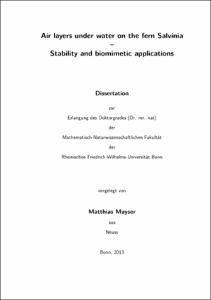Mayser, Matthias: Air layers under water on the fern Salvinia : Stability and biomimetic applications. - Bonn, 2014. - Dissertation, Rheinische Friedrich-Wilhelms-Universität Bonn.
Online-Ausgabe in bonndoc: https://nbn-resolving.org/urn:nbn:de:hbz:5n-36191
Online-Ausgabe in bonndoc: https://nbn-resolving.org/urn:nbn:de:hbz:5n-36191
@phdthesis{handle:20.500.11811/6095,
urn: https://nbn-resolving.org/urn:nbn:de:hbz:5n-36191,
author = {{Matthias Mayser}},
title = {Air layers under water on the fern Salvinia : Stability and biomimetic applications},
school = {Rheinische Friedrich-Wilhelms-Universität Bonn},
year = 2014,
month = may,
note = {Many plants and animals feature superhydrophobic surfaces capable of retaining a layer of air when submerged under water. The most persistent air layers can last for weeks and even month and are maintained by hairy surfaces structures. Such under water air retaining surfaces might be of high interest for future biomimetic applications e.g. drag reducing ship coatings. This study examines the air layer stability of four Salvinia species with different hair shapes under static and pressure conditions as well as the technical transfer of such air layers into technical application.
The air volumes held on Salvinia’s upper leaf surfaces is precisely measured. Therefore a new measurement setup based on strain gages is established which is capable of detecting air volumes under water with high resolution and a large detection range. The air volumes on the four different Salvinia species vary between 0.15 and 1 l/m2 depending on the size of the corresponding hairs, their spacing and their volume.
The novel measurement system allows for the first time to monitor the volume of air layers and its decrease over time. With this method the air layer persistence of the different Salvinia species is described. Three species display a continuous air loss over time (excluding the influence of photosynthesis) caused by diffusion due to the pressure difference between the air in the gas film and the air above the surface. S. oblongifolia displays a completely different progress of air loss. It loses air in a two step process. Due to its dome shaped emergences the air water interface experiences a higher degree of support when it reaches the level of the emergences, achieves a higher curvature and can thereby counteract diffusion. The remaining air leaves the leaf only when it starts to decay.
The air layer stability under pressure fluctuations is analyzed. While three of the four species (all except S. oblongifolia) are capable of maintaining air on the surface under the pressures experienced on ship hulls (2.5 bar) the degree of air coverage on the surface and the restoration capabilities of the air layer after lowering the pressure to ambient conditions vary largely between the species. Because of its hood shaped leaves S. cucullata displays the best performance under pressure fluctuations. An air bubble is formed inside the leaf. Its volume gets pressed in between the hairs as pressure increases, but up to 6 bar a large portion of the surface remains covered with air. Accordingly the air layer restores almost completely after the pressure is released.
Different technical under water air retaining surfaces are investigated. Flock surfaces confirmed the influence of hair length, thickness and density on air layer persistence. Measurements with technical Salvinia-effect surfaces also indicate that its hydrophilic pins not only prevent air bubble extraction from gas film but might also increase air layer persistence in static conditions. The reasons are not fully understood though. Additionally a new low cost replication technique is resented which allows of reproducing closed loop structures like the sophisticated egg beater hairs and could hence be utilized for the production of large technical under water air retaining surfaces.
New insights in the stability of air layers are generated, design schemes deduced for new technical air retaining surfaces and a new production technique provided for such surfaces. Applied on ship hulls, micro fluidics or in the fluid transport systems these findings could have a high economic and ecologic value by leading to a substantial reduction in energy consumption.},
url = {https://hdl.handle.net/20.500.11811/6095}
}
urn: https://nbn-resolving.org/urn:nbn:de:hbz:5n-36191,
author = {{Matthias Mayser}},
title = {Air layers under water on the fern Salvinia : Stability and biomimetic applications},
school = {Rheinische Friedrich-Wilhelms-Universität Bonn},
year = 2014,
month = may,
note = {Many plants and animals feature superhydrophobic surfaces capable of retaining a layer of air when submerged under water. The most persistent air layers can last for weeks and even month and are maintained by hairy surfaces structures. Such under water air retaining surfaces might be of high interest for future biomimetic applications e.g. drag reducing ship coatings. This study examines the air layer stability of four Salvinia species with different hair shapes under static and pressure conditions as well as the technical transfer of such air layers into technical application.
The air volumes held on Salvinia’s upper leaf surfaces is precisely measured. Therefore a new measurement setup based on strain gages is established which is capable of detecting air volumes under water with high resolution and a large detection range. The air volumes on the four different Salvinia species vary between 0.15 and 1 l/m2 depending on the size of the corresponding hairs, their spacing and their volume.
The novel measurement system allows for the first time to monitor the volume of air layers and its decrease over time. With this method the air layer persistence of the different Salvinia species is described. Three species display a continuous air loss over time (excluding the influence of photosynthesis) caused by diffusion due to the pressure difference between the air in the gas film and the air above the surface. S. oblongifolia displays a completely different progress of air loss. It loses air in a two step process. Due to its dome shaped emergences the air water interface experiences a higher degree of support when it reaches the level of the emergences, achieves a higher curvature and can thereby counteract diffusion. The remaining air leaves the leaf only when it starts to decay.
The air layer stability under pressure fluctuations is analyzed. While three of the four species (all except S. oblongifolia) are capable of maintaining air on the surface under the pressures experienced on ship hulls (2.5 bar) the degree of air coverage on the surface and the restoration capabilities of the air layer after lowering the pressure to ambient conditions vary largely between the species. Because of its hood shaped leaves S. cucullata displays the best performance under pressure fluctuations. An air bubble is formed inside the leaf. Its volume gets pressed in between the hairs as pressure increases, but up to 6 bar a large portion of the surface remains covered with air. Accordingly the air layer restores almost completely after the pressure is released.
Different technical under water air retaining surfaces are investigated. Flock surfaces confirmed the influence of hair length, thickness and density on air layer persistence. Measurements with technical Salvinia-effect surfaces also indicate that its hydrophilic pins not only prevent air bubble extraction from gas film but might also increase air layer persistence in static conditions. The reasons are not fully understood though. Additionally a new low cost replication technique is resented which allows of reproducing closed loop structures like the sophisticated egg beater hairs and could hence be utilized for the production of large technical under water air retaining surfaces.
New insights in the stability of air layers are generated, design schemes deduced for new technical air retaining surfaces and a new production technique provided for such surfaces. Applied on ship hulls, micro fluidics or in the fluid transport systems these findings could have a high economic and ecologic value by leading to a substantial reduction in energy consumption.},
url = {https://hdl.handle.net/20.500.11811/6095}
}






